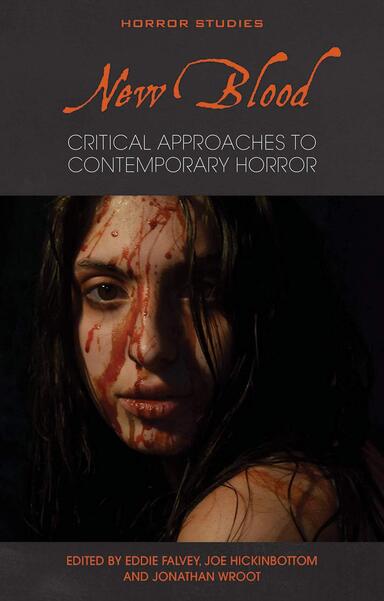
TITLE: New Blood: Critical Approaches to Contemporary Horror
AUTHOR: Eddie Falvey, Joe Hickinbottom and Jonathan Wroot (Eds)
PUBLISHER: University of Wales Press
ISBN: 9781786836342
PODCAST EPISODE: None
REVIEWER: Hilary Wilson
New Blood: Critical Approaches to Contemporary Horror edited by Eddie Falvey, Jonathan Wroot, and Joe Hickinbottom is one of the newer books in the University of Wales Press Horror Studies series. The Horror Studies series seeks to bring contemporary academic writing to the understudied genre of horror. These books cover a vast variety of horror media, and this newer entry is no different - television series, web series, ‘creepypasta’, and film were all touched upon within this set of 13 essays.
New Blood focuses upon media released since the year 2000. The essays cover a diverse array of topics - including analyses of new categories and subgenres ripe for critical study such as ‘prestige horror’,‘ digital folk horror’, ‘torture porn’ and the more newly emerged ‘desktop horror’ and ‘Netflix horror’. While the shows and films discussed in the essays do include such critical darlings as Stranger Things and It Follows they also spend time upon less prestigious ‘video nasties’ such as Bloody Muscle Body Builder In Hell and, more shockingly, the infamous and little studied A Serbian Film.
This book does not shy away from the more contentious debates within the horror studies field. David Church, in his essay “Apprehension Engines”, details the debate surrounding the naming of ‘prestige’ or ‘auteur’ horror and how much it has polarized fans of the genre over the past few years. Likewise, Hickinbottom provides interesting insight into the mystery of Takashi Miike’s reputation in the west as a horror master when so little of his actual cinematic output is horror in “A Master of Horror?”
There is ample attention paid to marketing and how that has influenced the marketing of horror media over the years. Everything from horror-only conventions to the patently false marketing of ‘extreme horror’ to draw in more fans is considered - as well as how streaming services have altered the horror scene through creative casting to draw in viewers who might otherwise shy away from that sort of content.
By delving into the often ignored mire of torture porn and video nasties, as well as the contentious question of the value of digital folklore and prestige horror as valid areas of study, these essays challenged broadly held assumptions about what art is and what is worthy of study. I believe that many will come away from this book with new movies to watch, and a deeper appreciation of genres they might otherwise have ignored.
AUTHOR: Eddie Falvey, Joe Hickinbottom and Jonathan Wroot (Eds)
PUBLISHER: University of Wales Press
ISBN: 9781786836342
PODCAST EPISODE: None
REVIEWER: Hilary Wilson
New Blood: Critical Approaches to Contemporary Horror edited by Eddie Falvey, Jonathan Wroot, and Joe Hickinbottom is one of the newer books in the University of Wales Press Horror Studies series. The Horror Studies series seeks to bring contemporary academic writing to the understudied genre of horror. These books cover a vast variety of horror media, and this newer entry is no different - television series, web series, ‘creepypasta’, and film were all touched upon within this set of 13 essays.
New Blood focuses upon media released since the year 2000. The essays cover a diverse array of topics - including analyses of new categories and subgenres ripe for critical study such as ‘prestige horror’,‘ digital folk horror’, ‘torture porn’ and the more newly emerged ‘desktop horror’ and ‘Netflix horror’. While the shows and films discussed in the essays do include such critical darlings as Stranger Things and It Follows they also spend time upon less prestigious ‘video nasties’ such as Bloody Muscle Body Builder In Hell and, more shockingly, the infamous and little studied A Serbian Film.
This book does not shy away from the more contentious debates within the horror studies field. David Church, in his essay “Apprehension Engines”, details the debate surrounding the naming of ‘prestige’ or ‘auteur’ horror and how much it has polarized fans of the genre over the past few years. Likewise, Hickinbottom provides interesting insight into the mystery of Takashi Miike’s reputation in the west as a horror master when so little of his actual cinematic output is horror in “A Master of Horror?”
There is ample attention paid to marketing and how that has influenced the marketing of horror media over the years. Everything from horror-only conventions to the patently false marketing of ‘extreme horror’ to draw in more fans is considered - as well as how streaming services have altered the horror scene through creative casting to draw in viewers who might otherwise shy away from that sort of content.
By delving into the often ignored mire of torture porn and video nasties, as well as the contentious question of the value of digital folklore and prestige horror as valid areas of study, these essays challenged broadly held assumptions about what art is and what is worthy of study. I believe that many will come away from this book with new movies to watch, and a deeper appreciation of genres they might otherwise have ignored.